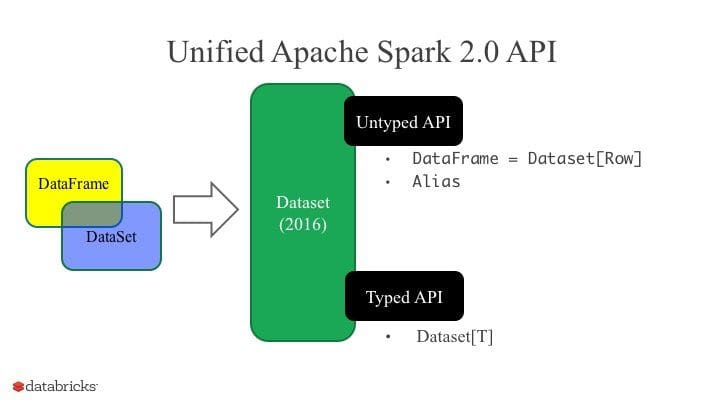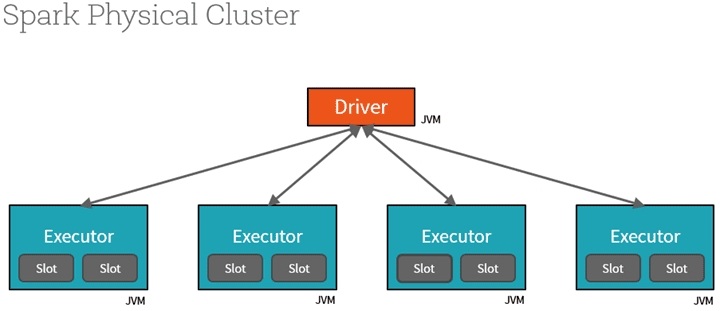Concepts
Apache Spark is a powerful open-source processing engine built around speed, ease of use, and sophisticated analytics, with APIs in Java, Scala, Python, R, and SQL. Spark runs programs up to 100x faster than Apache Hadoop MapReduce in memory, or 10x faster on disk. It can be used to build data applications as a library, or to perform ad-hoc data analysis interactively. Spark powers a stack of libraries including SQL, DataFrames, and Datasets, MLlib for machine learning, GraphX for graph processing, and Spark Streaming. You can combine these libraries seamlessly in the same application. As well, Spark runs on a laptop, Apache Hadoop, Apache Mesos, standalone, or in the cloud. It can access diverse data sources including HDFS, Apache Cassandra, Apache HBase, and S3.
It was originally developed at UC Berkeley in 2009. (Note that Spark’s creator Matei Zaharia has since become CTO at Databricks and faculty member at MIT.) Since its release, Spark has seen rapid adoption by enterprises across a wide range of industries. Internet powerhouses such as Netflix, Yahoo, and Tencent have eagerly deployed Spark at massive scale, collectively processing multiple petabytes of data on clusters of over 8,000 nodes. It has quickly become the largest open source community in big data, with over 1000 code contributors and with over 187,000 members in 420 Apache Spark Meetups groups.
2. RDD
At the core of Apache Spark is the notion of data abstraction as distributed collection of objects. This data abstraction, called Resilient Distributed Dataset (RDD), allows you to write programs that transform these distributed datasets.
RDDs are immutable distributed collection of elements of your data that can be stored in memory or disk across a cluster of machines. The data is partitioned across machines in your cluster that can be operated in parallel with a low-level API that offers transformations and actions. RDDs are fault tolerant as they track data lineage information to rebuild lost data automatically on failure.
Below is an Apache Spark code snippet using Python and RDDs to perform a word count.

3. DataFrame
Like an RDD, a DataFrame is an immutable distributed collection of data. Unlike an RDD, data is organized into named columns, like a table in a relational database. Designed to make large data sets processing even easier, DataFrame allows developers to impose a structure onto a distributed collection of data, allowing higher-level abstraction; it provides a domain specific language API to manipulate your distributed data; and makes Spark accessible to a wider audience, beyond specialized data engineers.
Below is an Apache Spark code snippet using SQL and DataFrames to query and join different data sources.

4. Dataset
Introduced in Spark 1.6, the goal of Spark Datasets is to provide an API that allows users to easily express transformations on domain objects, while also providing the performance and benefits of the robust Spark SQL execution engine.
Note, starting in Spark 2.0, the DataFrame APIs will merge with Datasets APIs, unifying data processing capabilities across all libraries. Because of unification, developers now have fewer concepts to learn or remember, and work with a single high-level and type-safe API called Dataset. Conceptually, the Spark DataFrame is an alias for a collection of generic objects Dataset[Row], where a Row is a generic untyped JVM object. Dataset, by contrast, is a collection of strongly-typed JVM objects, dictated by a case class you define, in Scala or Java.

5. MLlib
Apache Spark provides a general machine learning library -- MLlib -- that is designed for simplicity, scalability, and easy integration with other tools. With the scalability, language compatibility, and speed of Spark, data scientists can solve and iterate through their data problems faster.
From the inception of the Apache Spark project, MLlib was considered foundational for Spark’s success. The key benefit of MLlib is that it allows data scientists to focus on their data problems and models instead of solving the complexities surrounding distributed data (such as infrastructure, configurations, and so on). The data engineers can focus on distributed systems engineering using Spark’s easy-to-use APIs, while the data scientists can leverage the scale and speed of Spark core. Just as important, Spark MLlib is a general-purpose library, providing algorithms for most use cases while at the same time allowing the community to build upon and extend it for specialized use cases. To review the key terms of machine learning, please refer to Matthew Mayo’s Machine Learning Key Terms, Explained.
6. ML Pipelines
Typically when running machine learning algorithms, it involves a sequence of tasks including pre-processing, feature extraction, model fitting, and validation stages. For example, when classifying text documents might involve text segmentation and cleaning, extracting features, and training a classification model with cross-validation. Though there are many libraries we can use for each stage, connecting the dots is not as easy as it may look, especially with large-scale datasets. Most ML libraries are not designed for distributed computation or they do not provide native support for pipeline creation and tuning.

The ML Pipelines is a High-Level API for MLlib that lives under the “spark.ml” package. A pipeline consists of a sequence of stages. There are two basic types of pipeline stages: Transformer and Estimator. A Transformer takes a dataset as input and produces an augmented dataset as output. E.g., a tokenizer is a Transformer that transforms a dataset with text into an dataset with tokenized words. An Estimator must be first fit on the input dataset to produce a model, which is a Transformer that transforms the input dataset. E.g., logistic regression is an Estimator that trains on a dataset with labels and features and produces a logistic regression model.
Spark Cluster A collection of machines or nodes in the cloud or on-premise in a data center on which Spark is installed. Among those machines are Spark workers, a Spark Master (also a cluster manager in a Standalone mode), and at least one Spark Driver.
Spark Master As the name suggests, Spark master JVM acts as a cluster manager in a Standalone deployment mode to which Spark workers register themselves as part of a quorum. Depending on the deployment mode, it acts as a resource manager and decides where and how many Executors to launch, and on what Spark workers in the cluster.
Spark Worker The Spark worker JVM, upon receiving instructions from Spark master, launches executors on the worker on behalf of the Spark driver. Spark applications, decomposed into units of tasks, are executed on each worker’s Executor. In short, the worker’s job is to only launch an Executor on behalf of the master.
Spark Executor It’s a JVM container with an allocated amount of cores and memory on which Spark runs its tasks. Each worker node launches its own Spark Executor, with a configurable number of cores (or threads). Besides executing Spark tasks, an Executor also stores and caches all data partitions in memory.
Spark Driver Once it gets information from the Spark master of all the workers in the cluster and where they are, the driver program distributes Spark tasks to each worker’s Executor. The driver also receives computed results from each Executor’s tasks.

SparkSession and SparkContext As shown in the diagram, a SparkContext is a conduit to access all Spark functionality; only a single SparkContext exists per JVM. The Spark driver program uses it to connect to the cluster manager to communicate, and submit Spark jobs. It allows you to configure Spark configuration parameters. And through SparkContext, the driver can instantiate other contexts such as SQLContext, HiveContext, and StreamingContext to program Spark.
However, with Apache Spark 2.0, SparkSession can access all aforementioned Spark’s functionality through a single-unified point of entry. As well as making it simpler to access Spark functionality, it also subsumes the underlying contexts to manipulate data.
Spark Apps, Jobs, Stages and Tasks
An anatomy of a Spark application usually comprises of Spark operations, which can be either transformations or actions on your data sets using Spark’s RDDs, DataFrames or Datasets
APIs. For example, in your Spark app, if you invoke an action, such as collect() or take() on your DataFrame or Dataset
, the action will create a Job. A job will then be decomposed into single or multiple stages; stages are further divided into individual tasks; and tasks are units of execution that the Spark driver’s scheduler ships to Spark Executors on the Spark worker nodes to execute in your cluster. Often multiple tasks will run in parallel on the same executor, each processing its unit of partitioned dataset in its memory.
Last updated
Was this helpful?